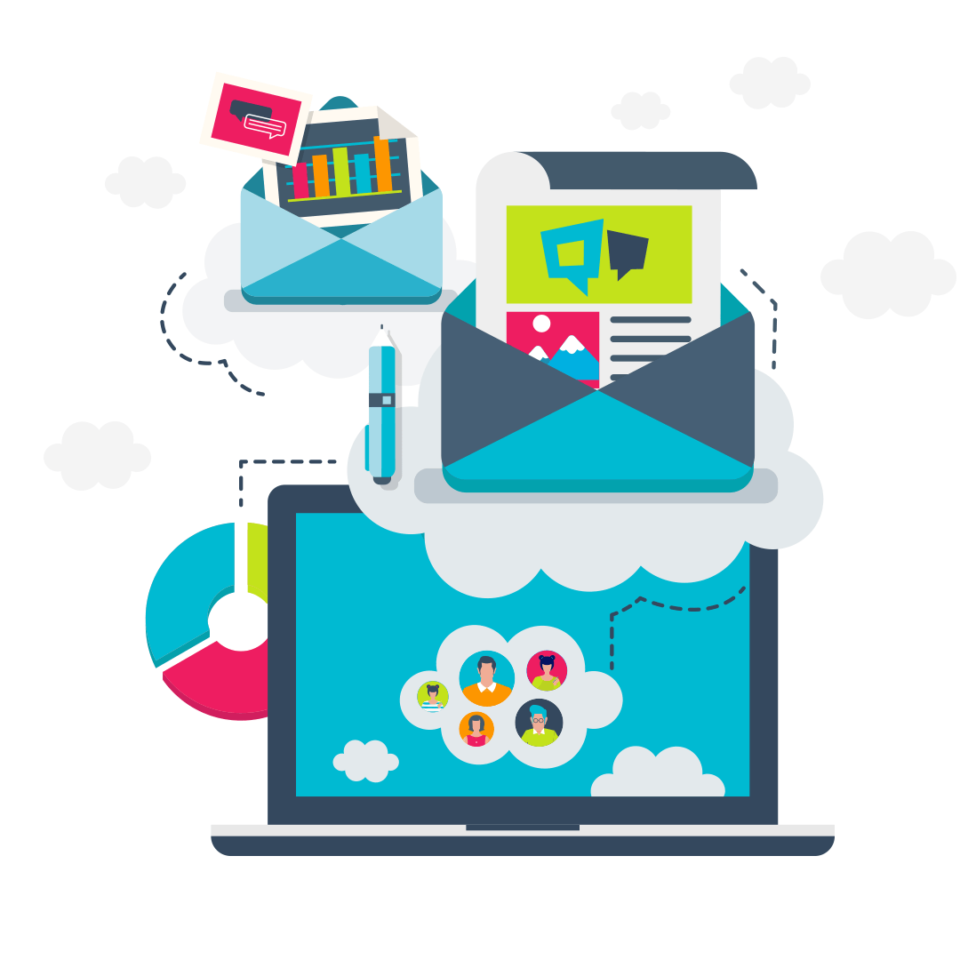NEWSLETTER – THE ROAD LESS TRAVELED
Digital marketing was my field of work even before I got a job at the agency. I learned a lot through blogs, webinars and courses – foreign ones because there were not many domestic ones at that time. By doing that, I discovered email marketing and realized how newsletter could be a powerful marketing tool. When I started to apply it in practice and use it in campaigns, no one could convince me anymore that it was an outdated communication channel that did not give results. However, the more clients and projects I had, the more I was surprised by the fact that email marketing is used very little and that this communication channel is completely and unfairly neglected. Since then, I’ve been on a constant mission to promote email marketing wherever I have the opportunity and to include it in projects where that is possible and appropriate. And it is appropriate in many cases.
If you need support in creating a newsletter campaign or strategy – contact us.
Justice for newsletter
The first marketing email was sent in 1978, 20 years before most Americans had their first email address. It was received by 400 users, and it earned an incredible 13 million dollars! The goal of Gary Turk, the marketing manager who sent that email, was to reach as many people as possible and that these people hear about a new product. Sounds familiar? Exactly. Even today, for many of us who are involved in marketing, the goal is to reach as many people as possible and inform them about our product. Email marketing is still a great way to achieve this. Even after all these years, it is one of the most effective forms of marketing.
Why is it then that sending the newsletter is often the road that is less travelled?
Trends are partly to blame, but also our tendency to use tools automatically. Nowadays, social networks are considered mandatory elements of every campaign. On top of that, we add Google promotion, influencers, combine it all with an event, and think that is enough. Sometimes it is, but there is almost no situation in which email marketing has no role to play.
Another situation is that we have tried with sending a newsletter, but we were not satisfied with the results. I responsibly claim that if you worked with email marketing and didn’t have any results, you weren’t doing something right.
It is essential to understand that email marketing is a form of direct marketing, i.e. that it is an opportunity to address the audience more directly in an environment that is much closer than social networks. Someone left you their email address, allowing you to directly contact them, to send them your message in their inbox and if you do it in the right way, you will make a big step towards building a relationship with the person who reads the email.
You give one; you get 43 – Still not enough?
Statistics say that today there are 4 billion email users worldwide. According to the Digital Marketing Association of America, for 1 dollar spent, an email generates 43 dollars. Yes, you’ve read that right, for one dollar invested, you get 43 dollars.
Then, 49% of respondents want to receive a newsletter from the brands they love and – to break the myth that young people don’t open emails – 73% of millennials use email as part of everyday communication. All this is enough to understand that email marketing is still one of the most valuable and powerful channels of communication. In fact, with powerful and high-quality content, strategic approach, and planned activities, email marketing is more powerful than ever!
Like any other channel of communication email marketing has its advantages but also challenges. First, you need to generate a quality customer base, then make sure that the open rate (percentage of open emails) is high, which largely depends on the subject of the email, then you need to create such content that the recipient of the email is interested in it and clicks on the links but also to stay on the list and doesn’t sign out after only a couple of received emails.
Sounds hard, but actually it’s enough to know your audience well and put their needs first. Also, to have quality content that justifies the trust that someone has shown you by leaving their email address. No one gives you their email address to send them content that is monotonous, boring, and that has no value. Or identical content that is already on the site and all other channels of communication.
What exactly do I mean – for example, if you have announced everywhere that a discount has started in your stores, in your newsletter, in addition to that information, add info about the items that are at the most significant discount, or are the most attractive at the moment. Your subscribers should have some benefit compared to those who have not yet subscribed to your newsletter. The benefit doesn’t have to be just an additional discount, but also information, free content, or some other perk, depending on what your business is about. There must be a difference and the reason for someone to subscribe to your newsletter, but also to remain subscribed.
If you send the newsletter in order to work with the same information that users can find on your other channels, there is no reason to open the email or to remain subscribed to the mailing list. This leads to the conclusion that for email marketing, as for any other channel, you need to create a strategy:
- what is the goal of this communication channel,
- how we will generate the user base,
- then the content of the newsletter needs to be discussed,
- determine the dynamics of sending,
- and finally, plan the analysis of the results.
The strategy is more or less the same as for any other communication channel. These are a total of five steps that show us how to master email marketing and safely take the road that is less traveled, and which hides a great potential for achieving business goals.
Open Sesame
We already said that the first challenge of email marketing is to generate a high-quality user base. After that, there is an obstacle called open rate, that is, when you have generated a database of users to whom you will send a newsletter, you will find yourself in front of a closed-door that stands between sent and open emails.

Source: static.tvtropes.org
If the newsletter you sent remains unread, all the effort invested is not worth much. Luckily, there are a few tactics that will get you to the right combination of words and make your email subject so good that people will really want to open it.
I can’t promise a magic formula, but here are a few tactics recommended by HubSpot that you can combine and test their results until you find the right recipe just for your audience:
- The first ingredient is FOMO (fear of missing out): people’s psychology is such that they are afraid of missing out on something and that is especially visible with millennials, so if they are your audience, try to put some element of urgency in the subject of the email (for example – only two more days, your bonus expires, etc.).
- The next trump card is curiosity, which naturally encourages people to take action, in this case, to open an email. For example, the most read book this month is… (I couldn’t stand not seeing which book it was).
- Pain points are always useful in the subject line of an email. Identify what prevents your audience from achieving some of their goals. For example – if you wake up tired, here are the solutions. If your subject is read by someone who is barely alive every morning when the alarm goes off, he will undoubtedly open the email to see what kind of solution you are offering for his problem.
- And here is another potent tactic, not only for the newsletter title but also for other types of content. It’s called social proof, which is actually what influencer marketing is based on. For example, three outfits recommended by Mara Mardashian or what moms say about the first year – these are the titles that contain social proof. An influencer, expert, community, or user testify that something you sell is good, and such social evidence has more meaning than what brands say for themselves.
By combining different tactics and analyzing what has been achieved, over time, it will be easier to find the right word combination for the email subject that will encourage users to open it. And when they open it, make sure that the content fulfills the announcement from the title, but that is a topic for another time.
We can do it together
Each channel of communication has its role and function. Email marketing is most often mentioned in connection with marketing automation and CRM systems, and those relate to larger systems, businesses, and shops. However, its role and potential are huge even without being part of a large system, especially for small and medium businesses, NGOs, internal communication, or individual projects that are constantly striving to optimize the budget and find highly profitable communication channels. Here you can find some examples of successful newsletters campaigns.
If you are in a situation where standard communication channels are slowing down, and you haven’t tried email marketing yet or didn’t have success with it, let us know so that we can create a strategy together and take the road that is less travelled. 😊



